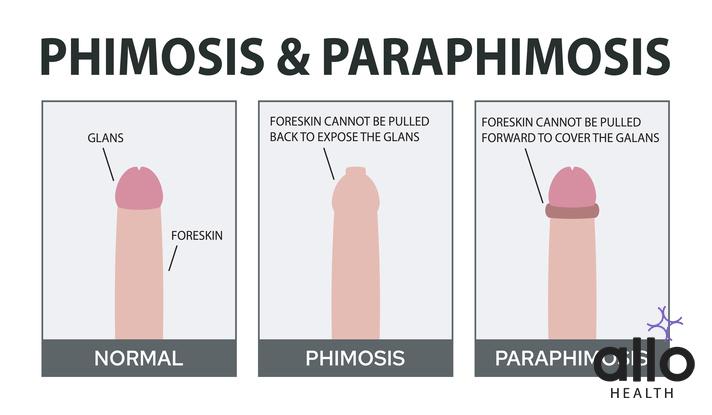Can Phimosis Cause Premature Ejaculation?

Allo Health is dedicated to personalized well-being, offering support and trusted information tailored to individual health goals. The platform emphasizes human-generated content, led by a distinguished medical team of experts, including physicians and sexual health specialists. Their commitment to credibility involves rigorous fact-checking, authoritative research, and continuous updates to ensure accurate, up-to-date information. Allo Health's unique approach goes beyond conventional platforms, providing expert-led insights and a continuous commitment to excellence, with user feedback playing a crucial role in shaping the platform's authoritative voice.

Ms Ashima Sahore has a masters in Clinical Psychology and has been working avidly in the space of therapy and research for the past 2 years. Her expertise lies in areas of stress, depression, anxiety, improving self-esteem, confidence, body appreciation among many others. She imbibes a wholesome approach to therapy and provides a non-judgemental, LGBTQAI+, and safe space.
Why This Was Upated?
Our experts continually monitor the health and wellness space, and we update our articles when new information became available.
Updated on 20 June, 2024
- Article was updated as part of our commitment to diversity, equity, and inclusion.

"The following blog article provides general information and insights on various topics. However, it is important to note that the information presented is not intended as professional advice in any specific field or area. The content of this blog is for general educational and informational purposes only.
Book consultation
The content should not be interpreted as endorsement, recommendation, or guarantee of any product, service, or information mentioned. Readers are solely responsible for the decisions and actions they take based on the information provided in this blog. It is essential to exercise individual judgment, critical thinking, and personal responsibility when applying or implementing any information or suggestions discussed in the blog."
Are you struggling with premature ejaculation (PE) and wondering if phimosis might be the cause? Both conditions, while related to sexual health have their own causes and symptoms. Many often wonder, can phimosis cause premature ejaculation? Here, our expert, weighs in on both conditions, so you can understand the relationships, and find out if phimosis can be a cause of premature ejaculation.
Understanding Phimosis
With phimosis, the foreskin of the penis is tight and cannot be fully retracted over the head of the penis. It can lead to various complications, including difficulties with hygiene, pain during intercourse, and potentially sexual dysfunction. While phimosis itself is not directly linked to premature ejaculation, it can indirectly contribute to the issue.
Premature ejaculation refers to the condition where a man ejaculates sooner than he or his partner desires during sexual activity, often before or shortly after penetration. It is a complex condition with multiple potential causes, including psychological, physiological, and interpersonal factors.
The condition can lead to discomfort and pain during sexual intercourse. The tightness of the foreskin may cause sensitivity and heightened arousal, leading to a heightened state of sexual excitement. This heightened arousal can potentially trigger premature ejaculation in some individuals. The discomfort and anxiety associated with the condition may also contribute to psychological factors that affect sexual performance.
The inability to fully retract the foreskin can interfere with proper hygiene, leading to the accumulation of bacteria and smegma under the foreskin. This can cause irritation and inflammation of the glans (head of the penis), known as balanitis. Balanitis can be a source of discomfort and pain, which may affect sexual performance and potentially contribute to premature ejaculation.
Premature ejaculation can have numerous other causes, including psychological factors such as performance anxiety, relationship concerns, or underlying medical conditions. Therefore, it is crucial to consult with a healthcare professional who can provide a thorough evaluation and appropriate treatment recommendations for both phimosis and premature ejaculation, if needed.
The Relationship Between Phimosis and Premature Ejaculation

There is limited scientific research specifically examining the direct relationship between phimosis and premature ejaculation. However, it is possible that phimosis can indirectly contribute to premature ejaculation through various mechanisms. Here are some potential ways in which phimosis may be related to premature ejaculation:
- Sensitivity and heightened arousal: Phimosis can cause the foreskin to be tight and constrict the glans (head of the penis), leading to increased sensitivity during sexual activity. This heightened sensitivity can result in heightened arousal and may lead to premature ejaculation in some individuals.
- Anxiety and psychological factors: Phimosis can cause discomfort and pain during sexual intercourse, which can create anxiety and psychological distress. These negative emotions can interfere with sexual performance and contribute to premature ejaculation. The fear of experiencing pain or embarrassment due to the condition can also induce performance anxiety, further exacerbating the concern.
- Reduced penile sensitivity: In some cases, the tightness of the foreskin may lead to reduced penile sensitivity due to chronic irritation and inflammation. Reduced sensitivity can affect the individual’s ability to perceive sexual stimulation accurately, potentially leading to difficulties in maintaining control over ejaculation.
- Hygiene-related concerns: Phimosis can hinder proper hygiene, leading to the accumulation of bacteria, smegma, and other substances under the foreskin. This can result in discomfort, inflammation, and infections such as balanitis. The presence of these conditions may cause pain and discomfort during sexual activity, potentially contributing to premature ejaculation.
Not all individuals with phimosis will experience premature ejaculation, and the impact of phimosis on premature ejaculation can vary from person to person. Premature ejaculation is a complex condition influenced by a combination of biological, psychological, and interpersonal factors. Other factors, such as underlying medical conditions, relationship concerns, or psychological factors like performance anxiety, can also contribute to premature ejaculation.
If you are experiencing concerns related to phimosis and/or premature ejaculation, it is advisable to consult with a healthcare professional or a urologist. They can provide a comprehensive evaluation, diagnose any underlying concerns, and recommend appropriate treatment options tailored to your specific situation.
Identifying Phimosis and Premature Ejaculation
Identifying Phimosis: Phimosis is characterized by the inability to retract the foreskin over the head of the penis. There are two main types of phimosis:
- Physiological Phimosis: This is a normal condition commonly found in infants and young children. The foreskin gradually becomes more flexible and retractable over time, usually by the age of 5 years. In physiological phimosis, there is no underlying pathology or inflammation.
- Pathological Phimosis: This refers to a condition where the foreskin remains tight and cannot be retracted even in adolescence or adulthood. Pathological phimosis can be caused by various factors, including scarring, inflammation, infection, or underlying medical conditions.
Here are some signs and symptoms of phimosis:
- Difficulty or inability to retract the foreskin fully or partially.
- Pain or discomfort during attempts to retract the foreskin.
- Redness, swelling, or inflammation of the foreskin or glans.
- Discomfort or pain during sexual intercourse.
- Poor hygiene due to the inability to clean under the foreskin properly, leading to accumulation of smegma and potential infections.
Identifying Premature Ejaculation: Premature ejaculation refers to the condition in which a man consistently ejaculates earlier than he or his partner desires during sexual activity. It is crucial differentiate premature ejaculation from occasional instances of rapid ejaculation, as it requires persistent and recurrent occurrences.
Here are some key features and criteria used to diagnose premature ejaculation:
- Ejaculation time: The most widely accepted definition of premature ejaculation is ejaculation that occurs within about one minute of vaginal penetration or even before penetration in severe cases (known as “rapid ejaculation”). However, it’s worth noting that the time threshold may vary depending on cultural and individual factors.
- Lack of control: In premature ejaculation, the individual experiences a lack of voluntary control over ejaculation. They may have difficulty delaying ejaculation or feel unable to control the timing of ejaculation.
- Distress or interpersonal difficulties: Premature ejaculation can cause distress, frustration, and dissatisfaction for both the individual and their partner. It may lead to interpersonal difficulties and impact the individual’s sexual relationship.
- Recurrence: Premature ejaculation is characterized by persistent and recurrent occurrences. It is not solely based on isolated incidents of rapid ejaculation.
If you suspect you have premature ejaculation, it is recommended to consult with a healthcare professional or a urologist. They can assess your symptoms, provide a proper diagnosis, and recommend suitable treatment options tailored to your specific situation.
Treatment Options for Phimosis and Premature Ejaculation
Phimosis: Phimosis refers to the condition where the foreskin of the penis is tight and cannot be pulled back over the head of the penis. Treatment options for phimosis may include:
- Topical Steroid Cream: A doctor may prescribe a steroid cream, such as betamethasone, which can help to soften and stretch the foreskin over time. The cream is applied to the tight area of the foreskin, and the stretching is typically done by the individual or their partner.
- Manual Stretching Exercises: This involves gently pulling back the foreskin to stretch it gradually. Be patient and gentle to avoid causing injury. This method can take several weeks or months to achieve results.
- Preputioplasty: This is a minor surgical procedure that involves making a small incision in the tight area of the foreskin to widen the opening. It is less invasive than a full circumcision and can be an effective treatment option.
- Circumcision: In severe cases where other treatments have been unsuccessful, circumcision may be recommended. This surgical procedure involves the removal of the foreskin. Circumcision is irreversible.
The choice of treatment will depend on the severity of the phimosis, personal preference, and the advice of a healthcare professional.
Premature Ejaculation: Premature ejaculation (PE) refers to the condition where a man ejaculates earlier than desired during sexual activity. Treatment options for premature ejaculation may include:
- Behavioral Techniques: Behavioral techniques include techniques such as the start-stop method and the squeeze technique. The start-stop method involves stopping sexual stimulation just before ejaculation and then starting again once the urge to ejaculate has subsided. The squeeze technique involves applying pressure to the base of the penis to prevent ejaculation. These techniques aim to increase control over ejaculation and can be practiced alone or with a partner.
- Counseling or Therapy: In some cases, premature ejaculation may have psychological or emotional causes. Counseling or therapy can help address any underlying psychological factors contributing to the condition, such as anxiety or relationship concerns. Techniques like cognitive-behavioral therapy (CBT) may be used to develop coping strategies and improve sexual performance.
- Medications: Certain medications may be prescribed to help delay ejaculation. Selective serotonin reuptake inhibitors (SSRIs), typically used as antidepressants, can have a side effect of delaying ejaculation. They are sometimes prescribed “off-label” for premature ejaculation.
The most common fears are fear of pain, bleeding, hypersensitivity of the penis glans, diminishes of their sexual pleasure, and their female sexual partners. Not all urologists believe that circumcision is necessary in all cases of phimosis.
Creams or sprays containing local anesthetics (such as lidocaine or benzocaine) can be applied to the penis to reduce sensitivity and delay ejaculation. These products should be used with caution and according to the instructions provided
It’s worth noting that the effectiveness of treatments for premature ejaculation can vary depending on the individual, and a combination of approaches may be required. It’s advisable to consult with a healthcare professional who can provide a proper diagnosis and recommend the most suitable treatment options for your specific situation.
Frequently Asked Questions
(1) Can phimosis cause erectile dysfunction (ED)?
While phimosis does not directly cause erectile dysfunction (ED), it can contribute to difficulties in achieving or maintaining an erection due to pain during sex or discomfort. Additionally, the psychological stress associated with phimosis may also impact erectile function.
(2) Can phimosis resolve on its own?
In some cases, particularly in children and adolescents, phimosis may resolve on its own as the foreskin becomes more elastic over time. However, for adults with acquired phimosis or severe cases, medical intervention may be necessary.
(3) Is circumcision the only treatment option for phimosis?
No, circumcision is not the only treatment option for phimosis. Less invasive treatments, such as topical steroid creams and stretching exercises, can be effective in mild to moderate cases. Circumcision may be recommended for more severe cases or when other treatments have been unsuccessful.
(4) Can premature ejaculation be cured permanently?
While there is no one-size-fits-all “cure” for PE, many individuals find success with a combination of treatments, including behavioural techniques, counselling, and medications. It’s essential to work closely with a healthcare professional to develop a tailored treatment plan that addresses your specific needs and concerns.
(5) Can phimosis cause premature ejaculation?
Phimosis itself does not directly cause premature ejaculation. Premature ejaculation refers to the condition where a man ejaculates earlier than desired during sexual activity. However, phimosis can indirectly contribute to premature ejaculation by causing discomfort or pain during intercourse, which may lead to heightened anxiety and a rush to ejaculation. The psychological distress and performance anxiety associated with phimosis can affect sexual performance and potentially contribute to premature ejaculation
(6) How does phimosis affect sexual function?
Phimosis can affect sexual function by causing pain or discomfort during sexual activity. The tight foreskin can make it difficult or even painful to retract the foreskin during intercourse, leading to discomfort and decreased pleasure for both partners. This may result in anxiety, reduced sexual desire, and difficulties in achieving or maintaining an erection. The impact on sexual function can vary depending on the severity of the phimosis and individual factors.
(7) Can treating phimosis improve premature ejaculation?
Treating phimosis can potentially improve premature ejaculation, especially if the premature ejaculation is related to the anxiety and psychological distress caused by the condition. By addressing and resolving the physical discomfort or pain associated with phimosis, individuals may experience reduced anxiety and improved sexual confidence, which can positively impact ejaculatory control. Additional interventions, such as behavioral techniques or counseling, may be necessary to address premature ejaculation directly.
(8) Are there any specific exercises to treat both phimosis and premature ejaculation?
While exercises may be helpful in managing both phimosis and premature ejaculation, the specific exercises differ for each condition. For phimosis, manual stretching exercises can be performed to gradually stretch the tight foreskin over time. These exercises involve gently pulling back the foreskin to widen the opening. On the other hand, exercises to address premature ejaculation usually involve behavioral techniques, such as the start-stop method or the squeeze technique. These exercises aim to increase control over ejaculation.
(9) Should I seek medical advice for both phimosis and premature ejaculation?
Yes, it is advisable to seek medical advice for both phimosis and premature ejaculation. Consulting with a healthcare professional, such as a urologist or a sexual health specialist, can provide a proper diagnosis and guidance on the most appropriate treatment options for your specific situation. They can evaluate the severity of phimosis, determine if it requires treatment, and recommend suitable interventions. Similarly, if premature ejaculation is causing significant distress or affecting your sexual satisfaction, seeking medical advice can help identify the underlying causes and provide appropriate treatment recommendations. Remember that healthcare professionals are trained to address these concerns and can provide personalized advice based on your individual circumstances.
(10) Can a tight foreskin cause erectile dysfunction?
A tight foreskin, also known as phimosis, can potentially contribute to erectile dysfunction (ED) in some cases. Here’s a detailed explanation:
- Physical Discomfort: Phimosis can cause physical discomfort or pain during sexual activity. This discomfort can be a distraction and interfere with sexual arousal and the ability to achieve or maintain an erection. The tight foreskin may restrict the movement of the penile skin, leading to discomfort and difficulty in fully retracting the foreskin, which can affect the quality of sexual experiences.
- Psychological Factors: Phimosis can also have psychological effects that contribute to erectile dysfunction. Men with phimosis may experience anxiety, embarrassment, or self-consciousness about their condition. This psychological distress can lead to performance anxiety, affecting sexual confidence and the ability to achieve or sustain an erection. The fear of pain or discomfort during sexual activity can create a cycle of worry and anticipation, further exacerbating the problem.
- Reduced Sensitivity: Phimosis can potentially result in reduced penile sensitivity. The tight foreskin can inhibit the exposure of the glans penis (head of the penis) and reduce direct stimulation during sexual activity. Diminished sensitivity may make it more challenging to achieve and maintain an erection.
- Blood Flow: Erectile function relies on adequate blood flow to the penis. In some cases, phimosis can lead to reduced blood flow to the penile tissues. The constriction caused by the tight foreskin may impede proper blood circulation, potentially affecting the ability to achieve and sustain an erection.
If you suspect that phimosis is contributing to erectile dysfunction, it is recommended to consult with a healthcare professional, such as a urologist. They can evaluate your condition, assess any potential contributing factors, and recommend appropriate treatment options. Treating the underlying phimosis, whether through stretching exercises, topical creams, or surgical intervention, may help alleviate the physical and psychological factors contributing to erectile dysfunction.
Understanding the connection between phimosis and PE is crucial for individuals struggling with these conditions. While phimosis does not directly cause PE, it can contribute to its development through increased sensitivity and anxiety. By identifying the symptoms of both phimosis and premature ejaculation and seeking appropriate treatment, you can improve your sexual health and regain control over your intimate experiences.







































